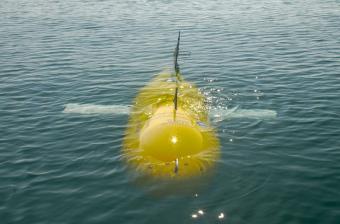The research the ALR is supporting at Thwaites Glacier will be fantastic for the science community, marking an important change in how we collect important ocean data to understand the effects of climate change
Engineers from the National Oceanography Centre (NOC) have headed out to the Thwaites Glacier in Antarctica with renowned autonomous underwater vehicle, 'Boaty McBoatface', to help understand what is causing ice loss from the glacier and better predict how its deterioration could contribute to sea level rise.
The NOC is providing its innovative technology as part of the TARSAN project, a 101-day ship-based expedition that will investigate atmospheric and oceanic conditions on two ice shelves on the coast near Thwaites Glacier. Boaty McBoatface, the state-of-the-art Autosub Long Range (ALR) vehicle, will travel under the glacier to largely unchartered territory, enabling scientists from the University of East Anglia (UEA) to identify how variations in its conditions may influence the behaviour and stability of ice shelves in the region. The study will shed light on how badly the glacier is being weakened by warming water and produce research that will benefit scientists around the world studying ice sheet behaviour in other locations.
The research mission will measure ocean properties into sub-ice shelf cavities, using the ALR and other complementary Autonomous Underwater Vehicles (AUV) to detail ocean transports and heat fluxes to better understand the impact of ocean and atmosphere on the ice-sheet change. Findings from the project will better predict how future changes in air, ocean or the ice will affect the loss of ice to the ocean in this region.
The team from the NOC is sending the Boaty under the ice shelf into poorly mapped and potentially very rough submarine topography and will control it from the Nathaniel B Palmer research ship using the NOC-developed Command and Control system (C2), which can re-task Boaty over Wi-Fi, via iridium satellite or using an acoustic modem once it is submerged. The ALR will measure temperature, salinity, current velocity, turbulence, turbidity and dissolved oxygen content of the water, as well as surveying several transects from the edge and towards the grounding line of the ice shelf. Depending on sea ice conditions, the shortest ALR dive could be a 24-hour, 540km round trip. Or, if the ice is favourable, dives could last up to three days.
The NOC has been developing obstacle avoidance technology to be placed on Boaty, with engineers completing trials in Loch Ness last month to ensure the success of the deployment. NOC engineers have added a forward-looking sonar to avoid steep obstacles ahead, and new retreat behaviours will enable the vehicle to turn around and return to the ship if the cavity gets too tight or if the terrain is impassable.
Dr Alex Phillips of the NOC said: “Our science and engineering teams have made enormous strides in pushing the boundaries of how we explore the world’s oceans with underwater technology. Autonomous underwater vehicles are vital equipment to enable oceanic research and we’re so excited to be joining the wider TARSAN team with Boaty, which will travel further under the Thwaites Glacier than ever before. The research the ALR is supporting at Thwaites Glacier will be fantastic for the science community, marking an important change in how we collect important ocean data to understand the effects of climate change.”
The TARSAN project is one of eight International Thwaites Glacier Collaboration’s (ITGC) research projects, which study the entire glacier to establish the impacts of what is known to be one of the most unstable glaciers in Antarctica.

